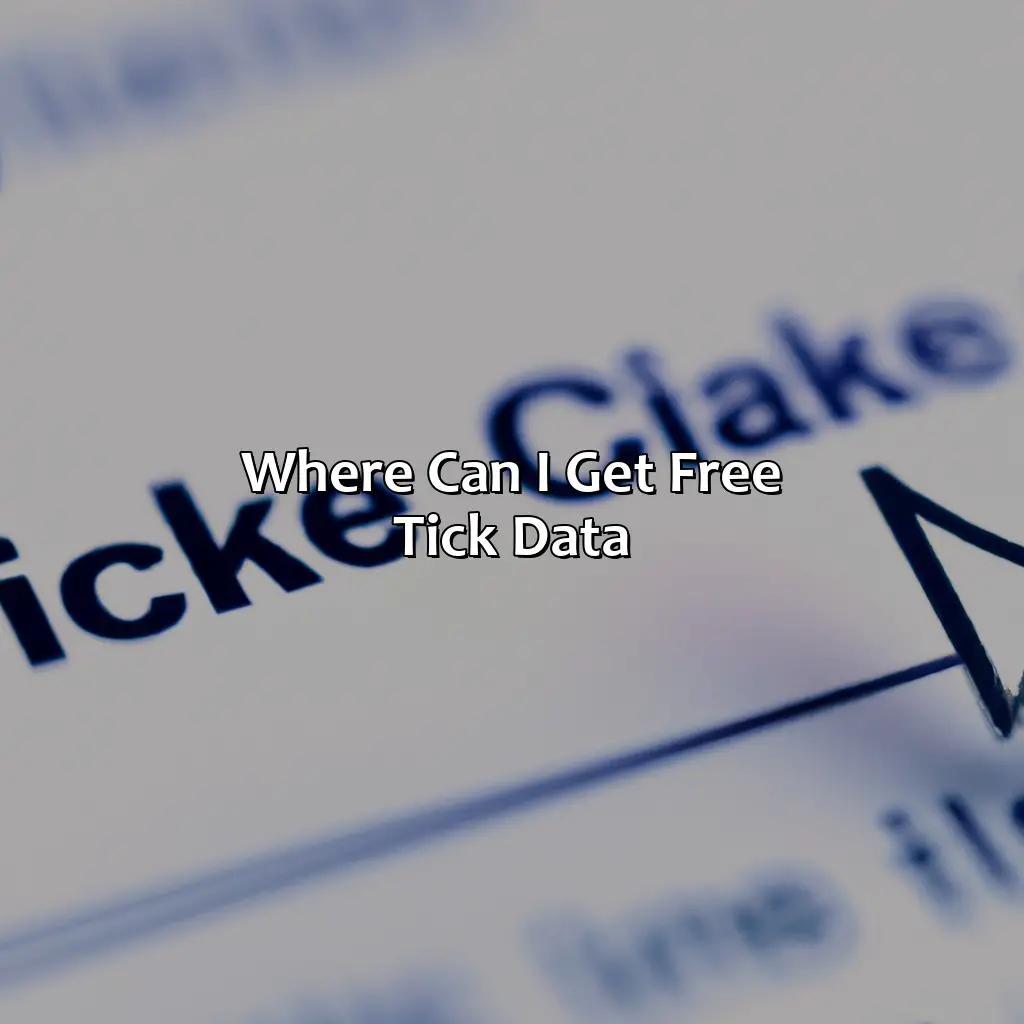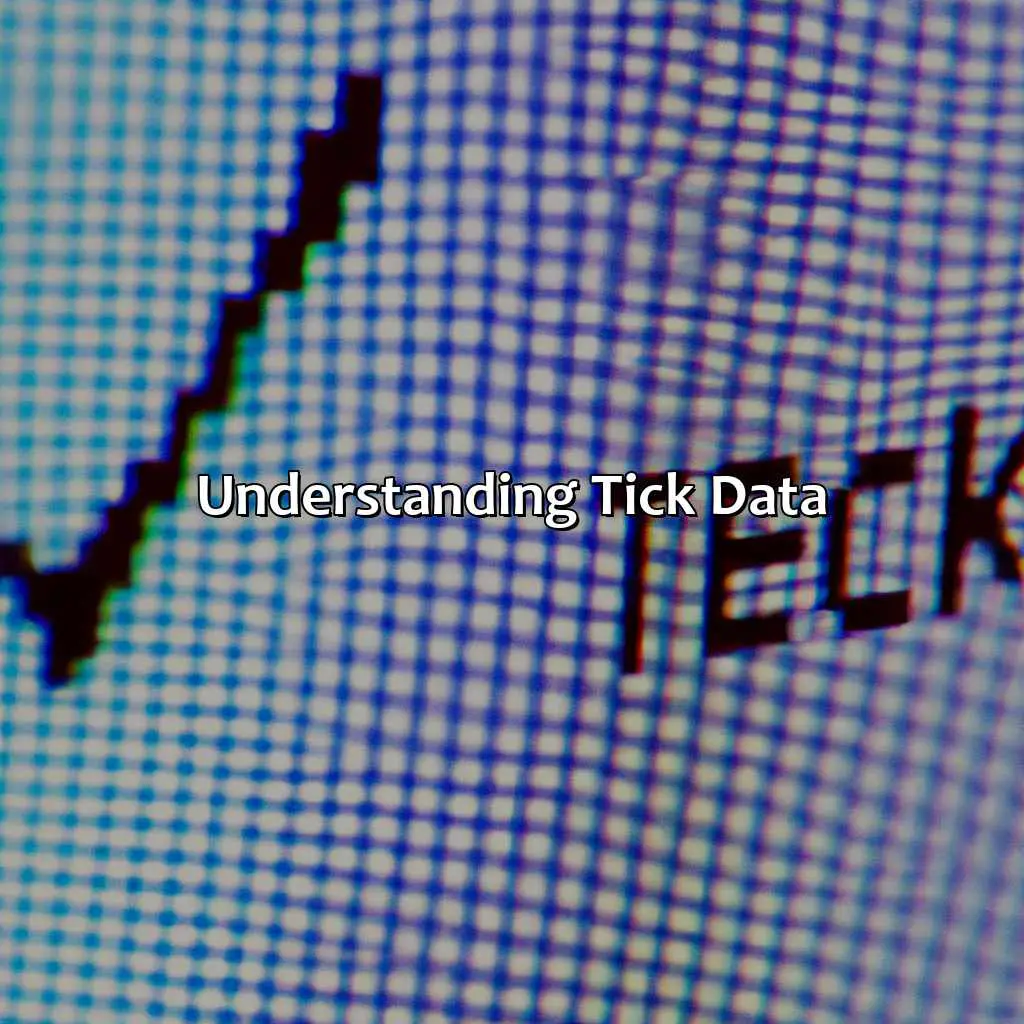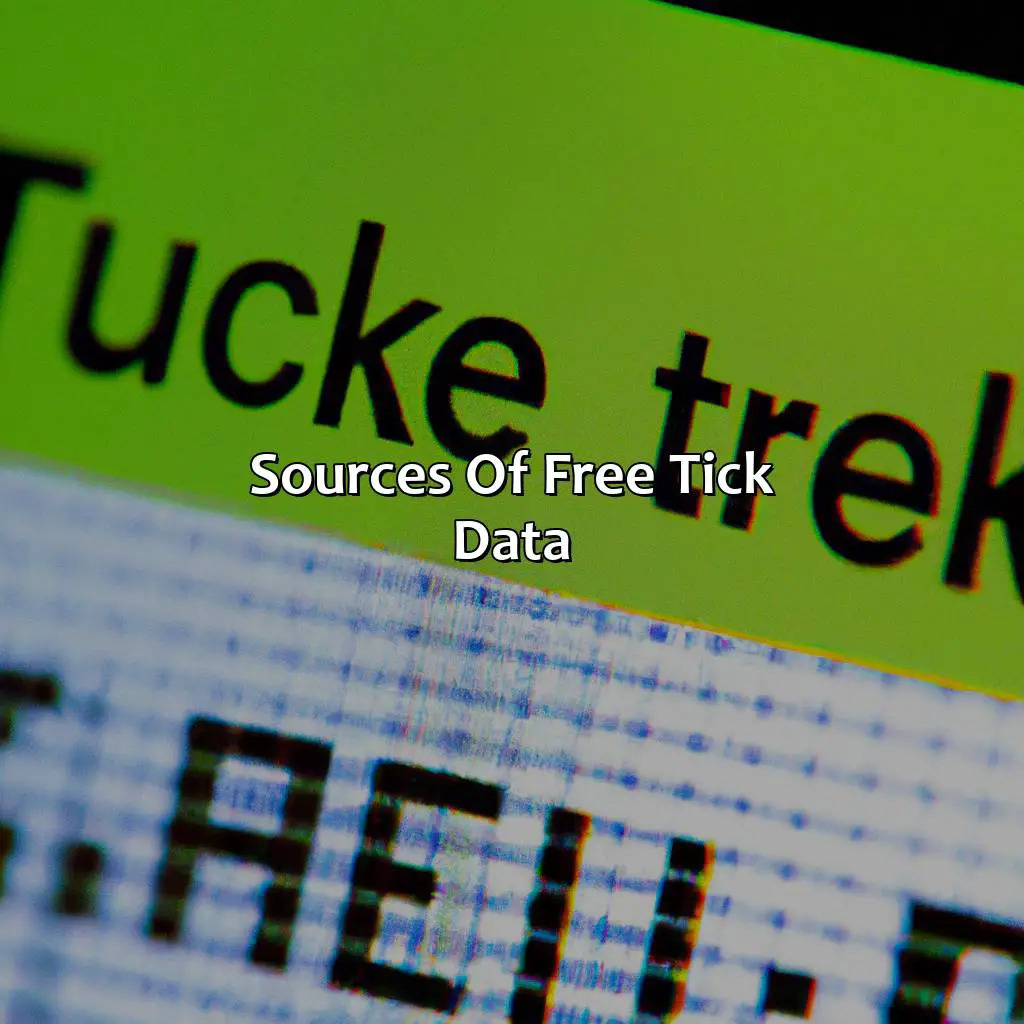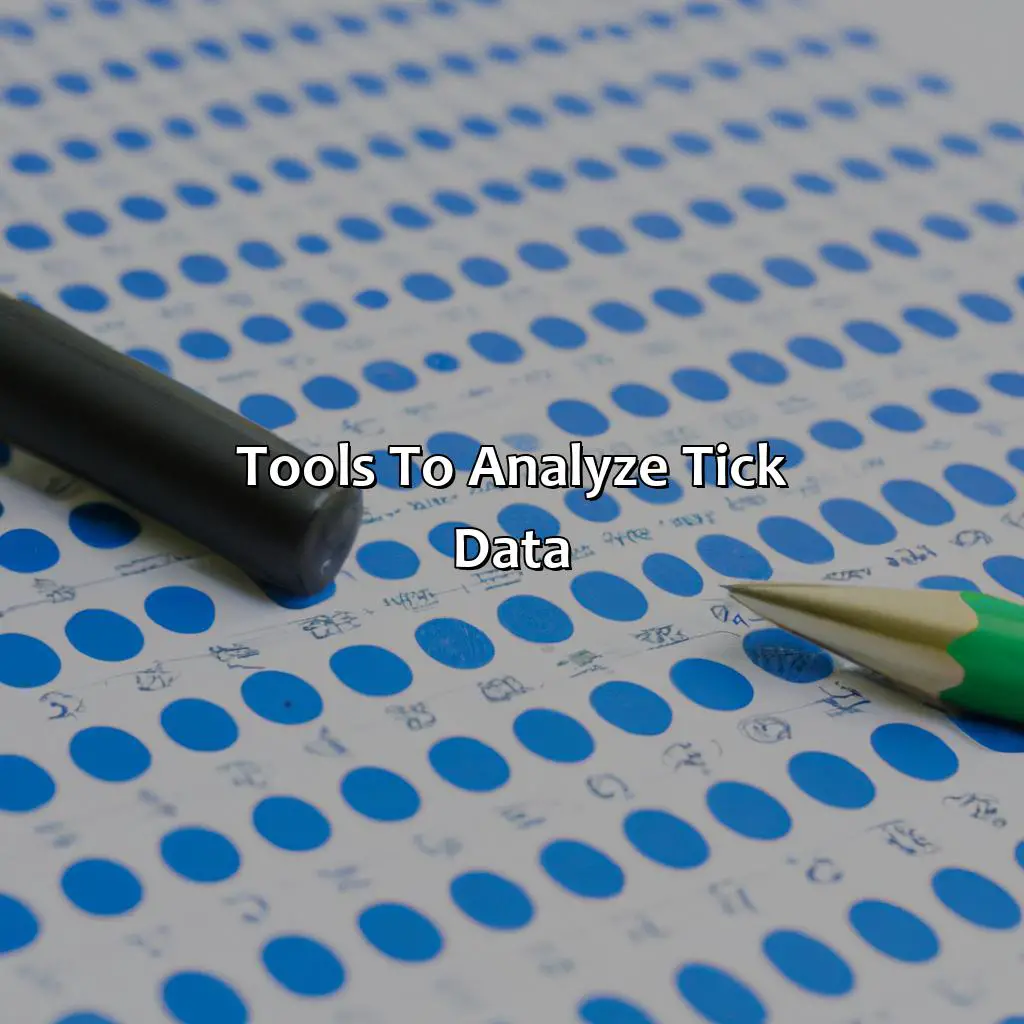
Key Takeaway:
- Tick data is a detailed record of every transaction made in a market, and can provide valuable insights for traders and investors. It can be obtained for free from various sources, including brokers, market data providers, exchange data websites, and third-party websites.
- Tick data is important because it provides granular details on price movements, trading volumes, and other market data, allowing traders and investors to make more informed decisions. It can be used to identify trends, analyze market volatility, and develop trading strategies.
- To download free tick data, users can follow specific steps for brokers and market data providers, exchange data websites, and third-party websites. However, users should be aware of data quality issues and limitations of free tick data, and use tools like tick data analysis software and Excel to analyze the data effectively.
Understanding Tick Data

Photo Credits: forexbrokerreport.com by Juan Johnson
Tick data is essential for traders and investors. What is it? Let’s define it quickly. Then, we’ll look into why it’s so important. We’ll discover how tick data can help you become a better trader. Get ready to explore the significance of tick data!
Definition of Tick Data
Tick data refers to financial market data that captures every trade or transaction done at a stock exchange or brokerage. It includes information such as the time of the trade, the price of shares traded, and volume transacted. Tick Data definition also encompasses pricing changes on instruments like currencies, futures, and other securities within a given interval. The quality of tick data is determined by its granularity; high-quality tick data captures more small price updates in high precision over an equal time period compared to lower-quality tick data sets.
The importance of this type of market information cannot be overstated as they help traders make informed decisions by providing an almost-real-time overview of how assets are performing in the markets. Due to its granular nature, it enables analysts and researchers to obtain quantitative insights into trading strategies that would otherwise not have been possible with traditional OHLC (Open/High/Low/Close) methods.
Free sources for Tick Data include – broker and market data providers’ websites, Exchange Data Websites, and third-party websites like Dukascopy or TrueFX. Brokers’ websites would require an account with them before granting access to their historical tick data offerings.
To download free Tick Data from broker websites and search engines requires specified steps that usually involve selecting the appropriate instrument; define periods corresponding with desired data before selection and downloading takes place by hitting the “Download” button on the website’s interface itself.
Tick Data analysis can be performed using tools such as special software packages or Excel spreadsheet programs having Direct Market Access (DMA) specifications.
Despite offering financial institutions a wealth of knowledge about price movements during trading periods, tick data has certain limitations. Current quotes provide two primary issues; firstly off-market prices can lead to inaccuracies in reports generated from Tick Data definition-derived analytics due to their forward-looking predictive nature. 2. not all participants record every trade resulting in gaps that lead to problems when generating summaries or conclusions.
Imagine analyzing your firm’s recent trading strategies, refining them for optimal revenue generation by factoring how different price movements affect the trade. Tick data offers invaluable insights second only to being physically present in the exchanges’ actual systems’ frontlines during trading hours.
Tick data may seem insignificant, but its importance lies in providing greater accuracy and granularity in market analysis.
Importance of Tick Data
Tick data is essential in financial market analysis, primarily for traders and analysts engaged in high-frequency trading activities. By analyzing increasing volumes of tick data at a granular level, the price movement and behavior of financial instruments can be better understood, leading to improved strategies and decision-making processes.
In this section, we present a table highlighting the Importance of Tick Data in financial market analysis. The following are some critical factors that make tick data so crucial:
| Importance of Tick Data |
|---|
| Analyzing transactions at a granular level help identify patterns and detect fraud. |
| Provides detailed insights into price fluctuations, helping traders make informed decisions about optimal entry and exit positions. |
| Facilitates testing and development of trading algorithms with more accuracy and precision. |
Other benefits of tick data include providing a clearer picture of liquidity levels, price volatility, transaction flow metrics, order book dynamics, and trade intensity measures.
It is noteworthy that tick data has limitations regarding its quality when obtained for free from public sources or in-house datasets. Therefore, it is essential to consider several factors such as latency issues or incomplete information before using free tick data for analytical purposes.
Pro tip: Always verify the reliability and authenticity of any source providing free tick data by checking their disclaimer policies before investing time analysing the datasets acquired from them.
Tick-tock, tick-tock, find free tick data around the clock: sources aplenty!
Sources of Free Tick Data

Photo Credits: forexbrokerreport.com by Bryan Wright
For free tick data, look no further! Brokers and market data providers offer it from their platform. Exchange data websites provide both historical and real-time data. Third-party websites have data and tools too. Get it all now!
Brokers and Market Data Providers
To know which brokers and market data providers offer free tick data, we have curated an illustrative table below:
| Broker/Market Data Provider | Free Tick Data Availability |
|---|---|
| Forex.com | Yes |
| Oanda | Yes |
| IG | Yes |
| TD Ameritrade | Yes |
| Interactive Brokers | Yes (with conditions) |
It is essential to confirm if the broker or market provider offers free tick data before committing to them blindly. Some brokers may require the trader to be their existing customer while others may offer it openly.
To optimize the acquisition of free tick data from these entities, try to be clear about what you need by creating manageable parameters and bookmark important pages where information about this is available.
Exchange your money for free tick data with these websites.
Exchange Data Websites
Exchange data websites are online platforms that offer tick data from specific exchanges. These websites provide users with quick and efficient access to historical tick data across various asset classes. A few notable exchange data websites include CME Group, Eurex, and Intercontinental Exchange (ICE).
| Exchange Data Website | Description |
|---|---|
| CME Group | Provides comprehensive market information for all major commodities markets, including futures and options quotes, charts, news, analysis and research. Offers daily and final settlement prices for cash-settled contracts as well as futures on physical commodities such as crude oil or gold. |
| Eurex | Europe’s leading derivatives exchange offers a broad range of international benchmark products. It covers global markets from one single platform – trading futures and options on German government bonds as well as the Euro Stoxx 50® index. |
| Intercontinental Exchange (ICE) | Offers transparent pricing & latent order book depth across its trading venues in energy, agriculture markets among others but is best known for its soft commodity offerings like coffee and sugar futures contracts. |
Furthermore, each exchange data website typically provides a user-friendly interface that allows users to access tick data quickly by entering specific dates or time intervals.
Don’t miss out on the extensive insights obtainable through exchange data websites; they provide users with a wealth of knowledge about the traded instruments’ past performance trends to make informed trading decisions. Accessing free historical tick data is made possible by these sources, opening up opportunities for traders who desire entry-level options without breaking the bank. Tick-tock, free tick data can be found on third-party websites around the clock.
Third-Party Websites
Third-party websites refer to platforms that offer free tick data which are not affiliated with any brokers or exchange data providers. These websites are usually run by independent developers, financial bloggers, or trading enthusiasts who have compiled tick data from different sources and made it available for public use. The availability of tick data on third-party websites is useful for traders who want to access historical market information, test their trading strategies, or develop their own tick analysis tools.
One benefit of using third-party websites is that they provide a wider range of tick data from multiple sources. This allows traders to compare and cross-verify the accuracy of the tick data before using them. Additionally, some third-party websites offer advanced features such as custom filters and charting tools that make it easier for traders to identify patterns in the market.
However, there are some limitations to using third-party websites for accessing free tick data.
- The quality and completeness of the data may vary depending on the source and method used for compiling it.
- There could be discrepancies in price quotes across different sources leading to inaccuracies in analysis.
- Last but not least, since these websites are often managed by individuals without professional expertise in finance or programming, there may be a lack of customer support and maintenance.
To overcome these limitations, traders can try using multiple third-party websites along with other sources like exchange data providers and brokers. They should also carefully evaluate the reliability and credibility of each website before downloading any data from them. It is also important to keep backups of downloaded data as some third-party websites may shut down abruptly or stop providing updates.
Tick-tock, tick-tock, here’s how to download free tick data and rock.
How to Download Free Tick Data

Photo Credits: forexbrokerreport.com by Bobby Rivera
If you want free tick data, it is best to get it from trusted sources. We offer three ideas:
- Get it from brokers and market data providers
- Get it from exchange data websites
- Get it from third-party websites
For each, we have detailed instructions on how to access the free data.
Steps to Download Tick Data from Brokers and Market Data Providers
To download tick data from brokers and market data providers, follow these steps:
- Login to your account on the broker or market data provider website.
- Search for the historical data section and select the instrument you want to download.
- Select the tick data option and specify the date range you require.
- Click on the download button and save the file in your preferred format.
It’s important to note that some brokers may charge for access to historical tick data. Additionally, it’s recommended to check if the downloaded data is adjusted for splits and dividends to ensure accuracy.
A reputable source of free tick data is Yahoo Finance, which provides up-to-date tick data for various instruments.
Don’t settle for stale tick data, download fresh exchange data with these easy steps.
Steps to Download Tick Data from Exchange Data Websites
Exchange Data Websites provide free tick data for traders to analyze and use in their trading decisions. To download the tick data, follow these simple steps:
- Visit the exchange data website that offers free tick data. This can be found through a search engine or by asking peers for recommendations.
- Identify the specific market and instrument you wish to analyze. Ensure that you select the correct symbol as mistakes can lead to incorrect analysis.
- Enter the date range you want to download the tick data for. Ensure that you choose a reasonable timeframe and not too long a duration if storage space is an issue.
- Select the format of your choice; this could be CSV, TXT or Excel format based on your preference.
- Click on ‘Download.’ Wait till download completes and extract files using WinZip or similar software if needed.
- Verify if downloaded files are clean, match with expected file volume size, and import it into your preferred analytical tool such as Python or R using necessary packages.
It is important to note that while exchange websites provide free Tick Data, they have restrictions such as low latency during peak trading hours due to increased traffic which means delays in delivery of real-time data compared to premium service offerings hence consideration must be taken into account before downloading critical Tick Data from free sources through exchange websites. If you delay downloading due to lack of storage space or other reasons, you will miss out on checking specific dates’ projections regarding price movements from previously analyzed patterns on them.
Take advantage of Exchange Data Websites providing unlimited downloads gratis efficient analyses from credible sources without having to pay for it whilst its still available. Find out how to snag tick data from third-party websites to improve your trading game.
Steps to Download Tick Data from Third-Party Websites
To download tick data from third-party websites, follow the steps given below:
- Identify a reputable third-party website that offers free tick data.
- Create an account on the website and log in.
- Search for the tickers or instruments you are interested in and select them.
- Define the date range of your data by selecting the start and end dates.
- Choose the format and frequency of your export file, such as CSV format or specific time intervals.
- Start downloading your tick data.
It is important to note that some third-party websites may require users to pay a subscription fee to access better quality, more up-to-date, and accurate tick data.
Download speeds can vary significantly depending on factors like internet connection speed, server capacity, geographical location, and number of users accessing the website at any given time.
A reputable source of free tick data is Dukascopy Bank’s data page that provides historical tick-by-tick data for a wide range of instruments across many different markets.
Tick data analysis made easy – discover the top tools for efficient data crunching!
Tools to Analyze Tick Data

Photo Credits: forexbrokerreport.com by Kevin Baker
Analysing tick data needs the right tools. Reliable tick data analysis software is perfect for complex analysis. For basic analysis, Excel is an excellent choice. Let’s check out the advantages of using these tools independently for analyzing tick data.
Tick Data Analysis Software
To analyze tick data, there are various tools available in the market. These software programs provide complex algorithms to help traders make intelligent decisions when it comes to trading in financial markets.
Below is a table that showcases some popular tick data analysis software programs along with their key features and pricing.
| Software Name | Key Features | Pricing |
| CQG Data Factory | Data Cleansing, Backtesting, Custom Charts | Free Trial, Paid Subscription available upon inquiry |
| NinjaTrader | Trade Simulator, Market Analyzer, Strategy Builder | $50/mo or $720/yr for the OrderFlow+ suite of features. |
| Rithmic Data Platforms and APIs | Data Visualization Tools, Automated Trading Strategies,Email Alerts/alerts through mobile apps | Paid Subscription only, Pricing given upon inquiry |
| GAIN Capital (FOREX.com) | Advanced Charting Tools, Trading Indicators,Currency Strength Index, Market News and Analysis | Paid Subscription only, pricing from $99/mo |
It is essential to choose the right trading software based on one’s trading style and budget. Some traders may prefer a basic data analysis tool with comprehensive charting capabilities, while others may need advanced systematic trading modules.
While these software programs can be useful in providing insightful analysis of tick data patterns, they are not a substitute for independent human analysis. It would be wise to understand both data quality and limitations before making trading decisions based on any tick data analysis software outputs.
To get ahead in the game of trading, it’s imperative to use the right tools to analyze tick data effectively. Don’t miss out on possible gains by failing to utilize the power of tick data analysis software; try out different software options through free trial platforms wherever applicable.
Unlock the power of tick data analysis with Excel and other spreadsheet programs.
Excel and Other Spreadsheet Programs
Spreadsheet programs like Excel can be used to analyze tick data. These programs allow for customization and flexibility in data analysis, with the ability to create charts and graphs for better visualization of the data. Additionally, features such as conditional formatting and sorting can be applied to tick data for better organization and understanding.
It is essential to ensure that the tick data downloaded is compatible with spreadsheet programs like Excel. Once downloaded, the data can be imported into Excel by using the ‘Data’ tab and selecting ‘From Text/CSV’. Here, users can select their downloaded file and specify the delimiter used in the file.
A pro tip would be to utilize keyboard shortcuts within spreadsheet programs like Excel to increase efficiency when working with large sets of tick data. For example, pressing Control + Shift + L will apply filters to columns in a selected table, allowing users to easily sort through large amounts of data.
Don’t rely on tick data alone– understanding its limitations is key to making accurate trading decisions.
Data Quality and Limitations

Photo Credits: forexbrokerreport.com by James Robinson
Gaining a deeper understanding of tick data? Let’s explore the factors affecting data quality, plus the limitations of free tick data. Discover the intricacies of tick data and how it influences the dependability and accuracy of your strategies.
Factors affecting Tick Data Quality
Tick data quality can be affected by various factors, resulting in an inaccurate analysis or incorrect interpretation of market trends. These factors encompass the size and operations of the exchange, data latency and completeness, among others.
| Factors affecting Data Quality | Description |
|---|---|
| Size and Operations of the Exchange | The amount and frequency of data generated by an exchange can affect database architecture and management, leading to issues such as missing or corrupted transactions. Also, less-active exchanges might have lower-quality instruments with narrow bid-ask spreads that tend not to be filled to their entirety, thereby concealing valuable information. |
| Data Latency and Completeness | Tick-by-tick data may have delays in capturing market events due to network connectivity or service maintenance issues. Furthermore, tick formation might leave out a few moments within bar time frames that were below a particular threshold level or were anomalous enough to discard excessive trades altogether. |
| Market Participants | Market participants behaving differently than historical trends or surging activity levels due to flash crashes or abrupt price gaps could result in outlier estimates if individual ticks are emphasized more than significant trends on how macro-events influence financial markets. |
In addition to these factors affecting data quality, traders must beware that free tick data often has limitations varying from lack of user support; limited timeframes available or incomplete datasets used for backtesting purposes diverging from live trading conditions.
Always remember that while tick data brings unique views on financial markets’ microstructure trading terrain is not without associated risks either.
As a trader who aims for an advantage over competitors in the trading space don’t miss out! Keep the upper hand when you utilize Quality Tick Data for your trading strategies today!
Free tick data may come with limitations, but hey, nothing in life is truly free…except for maybe the air we breathe.
Limitations of free Tick Data
Free tick data has some limitations that traders and investors should be aware of:
- The accuracy and completeness of free tick data may vary.
- Some sources may provide delayed data, which can be a disadvantage to traders who require real-time information.
- The frequency at which the data is updated may also vary, with some sources providing hourly or daily updates instead of real-time updates.
- Free tick data may not include all asset classes or markets, limiting its usefulness for those interested in trading a broad range of securities.
- The documentation provided with free tick data might not be comprehensive as compared to paid tick data.
- There are potential discrepancies between different sources of free tick data.
Additionally, it is recommended that traders consider using paid services for more reliable and precise data. Paid versions often offer higher quality and more frequent updates. One option is to use a combination of both free and paid services to validate each other’s results. Additionally, carefully considering the quality and limitations of free tick data sources will help ensure that traders make informed decisions when using this type of information.
Five Facts About Where To Get Free Tick Data:
- ✅ Free tick data can be found on websites such as Yahoo Finance and Google Finance. (Source: Investopedia)
- ✅ Some brokers, such as Interactive Brokers and TD Ameritrade, offer free access to historical tick data for their clients. (Source: Elite Trader)
- ✅ The website tickdata.com offers a free sample of tick data for various markets. (Source: Tick Data)
- ✅ The website histdata.com offers a limited amount of free tick data for forex pairs and cryptocurrencies. (Source: HistData.com)
- ✅ Some academic institutions offer access to free tick data for research purposes. (Source: Quora)
FAQs about Where Can I Get Free Tick Data?
Where can I get free tick data?
Free tick data sources are easy to find, but it can be tricky to get the quality data that you need for your project. Here are some sources where you can get free tick data:
What kind of tick data can I expect to get from these sources?
The type of tick data you’ll get varies depending on the source. However, most sources offer data on currency pairs, stocks, and futures contracts. Some sources may also provide options and other derivatives data.
Are there any restrictions on how I can use the tick data I download?
It depends on the source. Some free tick data sources restrict commercial use of their data, while others allow it. Others might require you to give attribution when using their data.
Can I get tick data for specific regions?
Yes. Many sources offer tick data specific to certain regions, such as Asia, Europe, or the Americas.
How often is the tick data updated?
The frequency of updates depends on the source. Some sources may update tick data every hour, while others might update it every minute or even every second.
Can I combine tick data from multiple sources?
Yes. However, before doing so, it’s essential to make sure that the sources are compatible and that the data is compatible. Additionally, ensure that you’re not violating any restrictions or agreements by combining data in this way.

